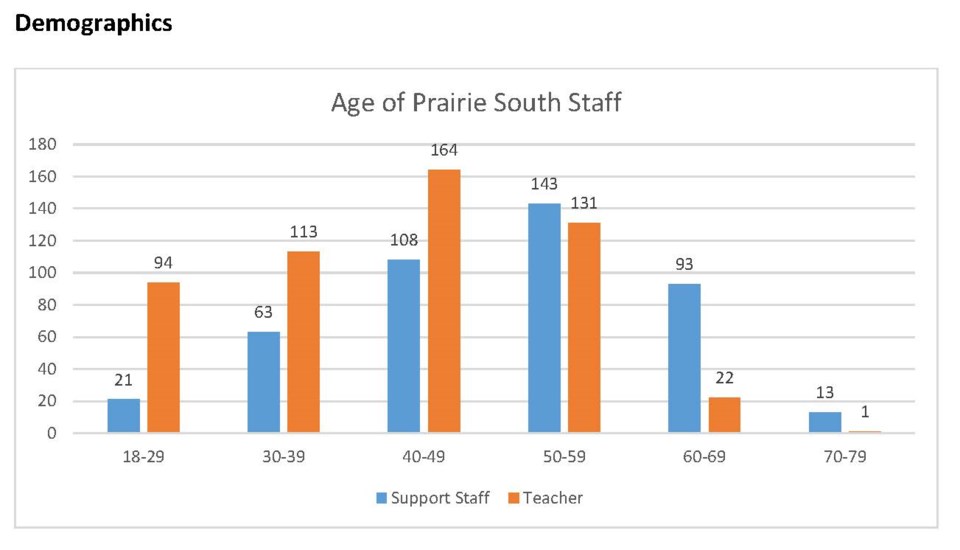Workplace injuries have affected Prairie South School Division regularly the last few years, but the number of incidents declined by nearly half during the 2019-20 school year.
In 2018 the Workers’ Compensation Board accepted 30 claims of workplace injury from the division, leading to 1,631 time-loss days and $239,460 in compensation and medical costs.
In 2019, the WCB accepted 32 claims of workplace injury, leading to 802 time-loss days and $94,754 in compensation and medical costs.
From Jan. 1 to Nov. 30, 2020, WCB accepted 15 claims of workplace injury, leading to 898 time-loss days but a rebate of $91,631 in compensation and medical costs.
“Prairie South has had a difficult time with workplace injuries (for) the last several years. We have several claims a year that are connected to people who have been hurt at work, so we’re always concerned about that,” said education director Tony Baldwin. “(However,) we’re quite happy to see that the number of claims that we had last year are quite a bit lower than in years’ past.”
The WCB penalty costs in 2020 declined by nearly $100,000 compared to 2019, which allowed the division to apply elsewhere, he continued. While that’s exciting, there are still concerns about the number of workplace injuries occurring and a desire to see zero injuries.
The workplace injury data was part of a report presented to the board of education during its January meeting. The report looked at the human resources department during the 2019-20 school year and all the areas that comprise that department.
Largest employer
Prairie South School Division is one of the largest employers in rural southern Saskatchewan, Baldwin said. It employs more than 900 people — 909.37 full-time equivalent (FTE) positions to be exact — in teaching, administration, finance, building operations and maintenance, transportation and leadership.
There are 431.10 FTE classroom teachers, followed by 236.81 FTE educational staff such as counsellors, social workers and educational assistants, 117.94 FTE transportation employees, 63.76 FTE building maintenance staff, 37.80 FTE principals and vice-principals, 17.96 FTE administrative and finance staff, and 5.0 FTE leadership positions.
During the 2019-20 school year, salaries and benefits totalled $64.5 million, which made up 76.1 per cent of the total budget.
 A chart shows the ages of teachers and other support staff within Prairie South School Division. Photo courtesy PSSD
A chart shows the ages of teachers and other support staff within Prairie South School Division. Photo courtesy PSSDStaff demographics
Prairie South has a fairly even distribution in ages among employees, the data shows. There are 563 support staff and teachers from ages 18 to 49, while there are 403 such employees who are 50 to 79.
One teacher in Mankota is 79 years old and is revered in that community, said Baldwin. That teacher has taught several generations of children from the same families.
Thirty-four employees — including 12 teachers and 22 support staff — retired during the 2019-20 school year, while 10 teachers and nine support staff resigned.
Since PSSD is a learning organization, it asks its staff to engage in learning opportunities to upgrade their qualifications, said Baldwin. The division spent $109,071.72 to help 38 teachers take 136 courses, while it spent $25,863 to help 20 support staff pursue 42 courses.
Attendance management
An attendance management system encourages staff members to be at work regularly so that students and the division benefit.
“This is a challenging piece. It’s not super popular with our staff because from time to time, we have to have some challenging conversations with people (who) feel like we’re being a little bit nosy,” said Baldwin.
While staff are encouraged to be at work, sometimes people can’t be for various reasons, so the HR department tracks those absences, he continued.
The total average days that classroom teachers took in absences in 2019-20 was 11.3 days, compared to 17.4 average days per employee in 2018-19.
In 2019-20, CUPE support staff took an average of 12.4 days per person in absences, compared to 18.0 days in 2018-19.
Out-of-scope support staff took an average of 9.9 days per person in absences during 2019-20, compared to an average of 10.2 days in 2018-19.
Bus drivers took an average of 9.5 days per person in absences in 2019-20, compared to 14.7 days in 2018-19.
Staff discipline
There were 1.2 million interactions between staff and students from September to November 2020, based on calculations Baldwin undertook recently. With this many interactions, sometimes the division has to engage in “corrective work” — or discipline — with staff.
“That’s rare work — quite difficult work for people — but it’s an important part of being a world-class organization, that we allow people to be accountable for the work and for their actions at work and support them when improvement is necessary,” said Baldwin.
In 2019-20, five letters of clarification/verbal warnings were given to support staff, one letter of discipline (warning/reprimand) was given to a support worker, and two workplace investigations into support staff were conducted.
One teacher filed a grievance with the Saskatchewan Teachers’ Federation, but that grievance was withdrawn or resolved, the report said. Two employees with CUPE filed grievances; both grievances were referred to arbitration, mediation or the labour board, and in the end, both grievances were resolved or withdrawn.
The next PSSD board meeting is Tuesday, Feb. 2.




